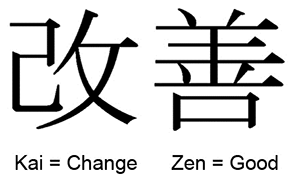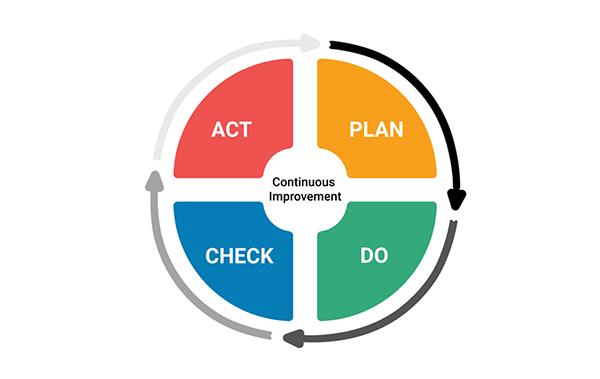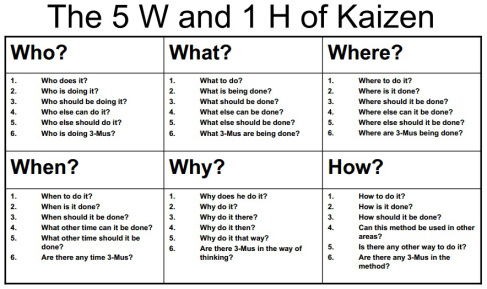The Kaizen Method in Project Management
(→The 10 Principles of Kaizen) |
(→Kaizen Events) |
||
| Line 31: | Line 31: | ||
== Kaizen Events == | == Kaizen Events == | ||
| − | + | #Set goals and provide any necessary background. | |
| − | + | #Review the current state and develop a plan for improvements. | |
| − | + | #Implement improvements. | |
| − | + | #Review and fix what doesn’t work. | |
| − | + | #Report results and determine any follow-up items. | |
== PDCA == | == PDCA == | ||
Revision as of 12:18, 20 February 2022
Contents |
Big Idea
Kaizen (改善, かいぜん), the Sino-Japanese word or Continuous Improvement (CI) is a strategy where employees at all levels of a company work together proactively to achieve regular, incremental improvements to the manufacturing process. In a sense, it combines the collective talents within a company to create a powerful engine for improvement.[1] It has a dual nature, as an action plan, where events are organized focusing on improving specific areas within a company, and as a philosophy, where all employees are actively engaged in suggesting and implementing improvements to the company.[2]
Kaizen is easy to understand, not hard to implement, and because of the broad concept behind the word: “change for the good,” there are many ways you can apply Kaizen in an organization.
Some of the advantages of implementing Kaizen in an organization are: 1.Utilization of Resources – Kaizen focuses on improving products through the utilization of existing resources (your people) to achieve incremental and continuous improvement. Kaizen is centered around making small changes instead of relying on massive changes or investments to gain improvements. 2.Increased Efficiency – Central to Kaizen methodology is the importance of providing a well-planned work area, eliminating unnecessary waste such as movement or in operations, and imparting proper training for all employees. 3.Employee Satisfaction – Kaizen is about creating an atmosphere of teamwork and change, where new ideas are encouraged. Team members are asked to examine the processes and make suggestions for improvement.[3]
History
Kaizen has its origins during World War II. When the United States entered the war, a group of Americans led by W. Edwards Deming, an engineer and statistician, set out to convert car factories into tank factories, quickly and with minimal resources. To achieve their lofty goal, Deming and his colleagues asked the workers to find small ways to improve their processes and quickly found out that small changes led to significant, measurable, and innovative results. After World War II, Deming traveled to Japan to help with manufacturing, as Japan was trying to rebuild. The Japanese took to heart the Deming principles. Businessman and industrial engineer Taiichi Ohno was the first Japanese business figure to translate Deming quality control principles into incredible, world-leading results. He called it the Toyota Production System (TPS). TPS, also known as “just-in-time” manufacturing, a system for reducing waste and maximizing efficiencies through continuous improvement. Kaizen is also identified as a significant example of a Lean business strategy. Taiichi Ohno used Kaizen in the Toyota factory to improve the quality of the vehicles. Initially, in companies like Ford or GM, the cars were assembled and sold without proper quality controls in place. Once the customers drove the cars and found problems, they would come back to the company to fix the issues. Deming principles changed that process so that every part is checked in the assembly line; if any problem is found, the assembly is stopped, and the issue is fixed then and there. Sounds so obvious now, but it was innovative then, and it revolutionized car manufacturing.
The 10 Principles of Kaizen
- Improve everything continuously.
- Abolish old, traditional concepts.
- Accept no excuses and make things happen.
- Say no to the status quo of implementing new methods and assuming how they will work.
- If something is wrong, correct it.
- Empower everyone to take part in problem-solving.
- Get information and opinions from multiple people.
- Before making decisions, ask “why”-questions five times to get to the root cause. (5 Why Method)
- Be economical. Save money through small improvements to spend the saved money on further improvements.
- Remember that improvement has no limits. Never stop trying to improve.
Kaizen Events
- Set goals and provide any necessary background.
- Review the current state and develop a plan for improvements.
- Implement improvements.
- Review and fix what doesn’t work.
- Report results and determine any follow-up items.
PDCA
Plan: develop a hypothesis Do: run experiment Check: evaluate results Act: refine your experiment; then start a new cycle
The 5 W and 1 H of Kaizen
Limitations
1.Short-term Kaizen events may lead to a shallow and short-lived burst of excitement that may be abandoned. 2.Companies with a culture of closed communication and territorialism need to focus on culture changes before something like Kaizen would be well received.
References
1.https://www.leanproduction.com/kaizen/#:~:text=Kaizen%20(Continuous%20Improvement)%20is%20a,a%20powerful%20engine%20for%20improvement. 2.https://www.kartalegal.com/insight/what-is-kaizen-in-law-methodology 3.https://planergy.com/blog/kaizen-method/ 4.https://www.kanbanchi.com/what-is-kaizen?fbclid=IwAR2M64xiCJZ9g95gLSQL-AW9HK4Q56e9NcVjaS9W9tcvNVlOhE4t_ptQuus


